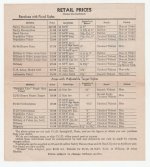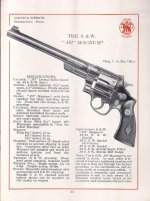Let me add to the "scarce" term often used here on the forum. As Mike states, scarce is where demand for the product exceeds supply, positively effecting value.
I have an example of what I think is a scarce S&W. Ed McGivern owned-guns are scarce by the definition of the word. Many S&Ws that Ed owned were M&P revolvers that typically would sell from $300 to $800 today. Those same guns associated with Ed McGivern, on the other hand, sell for thousands of dollars. I have been working on a database of McGivern owned guns and have documented nearly 90 guns to date. They only show up for sale at a couple of auctions every year. A scarce grouping of guns indeed.
Another gun that appears to be either scarce or rare is a sub-model M&P Target I have been doing some research on. It seems that there are just a few examples that show up over time. They are 4 screw square-butt 32 Winchester & 38 Special Target guns. Made for only months in 1905, they represent the very first square butt solid frame revolvers made by S&W. By my efforts, it can be accurately estimated that there were less than 100 of these 38 Target M&Ps in existence today. With the help of members here on the Forum, I have located only about 19 38 Special Targets and no 32 Winchester Targets have been found. They are as uncommon as Ed McGivern guns, but have little added value, so what are they, rare or scarce? Maybe neither.
I have an example of what I think is a scarce S&W. Ed McGivern owned-guns are scarce by the definition of the word. Many S&Ws that Ed owned were M&P revolvers that typically would sell from $300 to $800 today. Those same guns associated with Ed McGivern, on the other hand, sell for thousands of dollars. I have been working on a database of McGivern owned guns and have documented nearly 90 guns to date. They only show up for sale at a couple of auctions every year. A scarce grouping of guns indeed.
Another gun that appears to be either scarce or rare is a sub-model M&P Target I have been doing some research on. It seems that there are just a few examples that show up over time. They are 4 screw square-butt 32 Winchester & 38 Special Target guns. Made for only months in 1905, they represent the very first square butt solid frame revolvers made by S&W. By my efforts, it can be accurately estimated that there were less than 100 of these 38 Target M&Ps in existence today. With the help of members here on the Forum, I have located only about 19 38 Special Targets and no 32 Winchester Targets have been found. They are as uncommon as Ed McGivern guns, but have little added value, so what are they, rare or scarce? Maybe neither.



